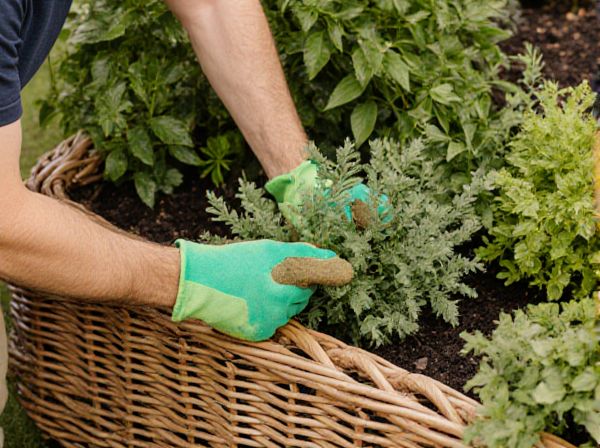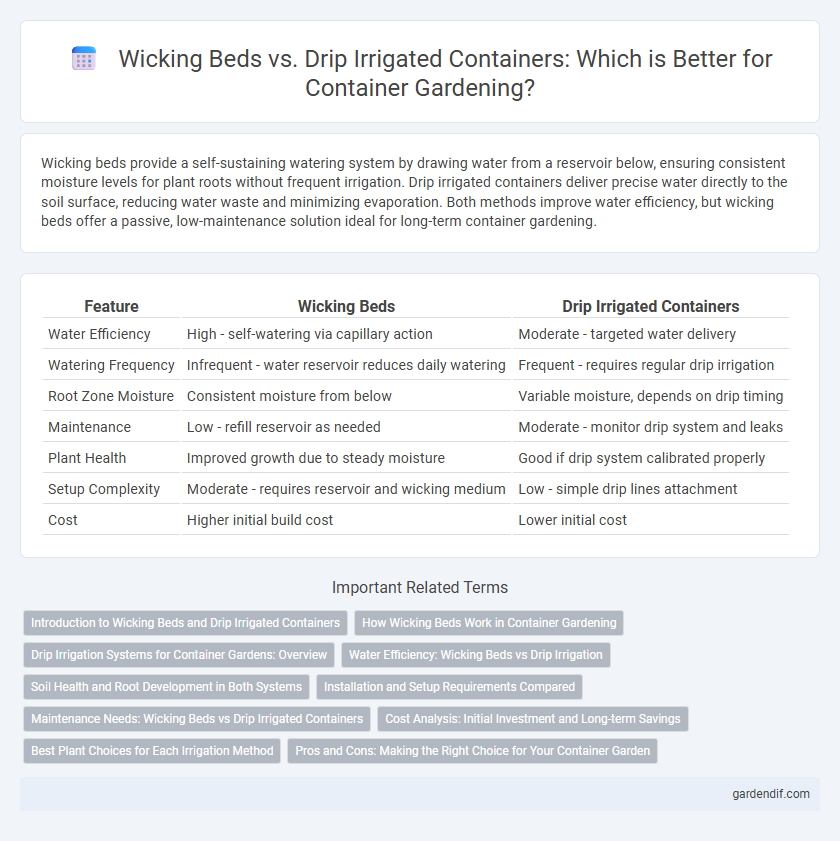
Wicking beds vs drip irrigated containers Illustration
Wicking beds provide a self-sustaining watering system by drawing water from a reservoir below, ensuring consistent moisture levels for plant roots without frequent irrigation. Drip irrigated containers deliver precise water directly to the soil surface, reducing water waste and minimizing evaporation. Both methods improve water efficiency, but wicking beds offer a passive, low-maintenance solution ideal for long-term container gardening.
Table of Comparison
| Feature | Wicking Beds | Drip Irrigated Containers |
|---|---|---|
| Water Efficiency | High - self-watering via capillary action | Moderate - targeted water delivery |
| Watering Frequency | Infrequent - water reservoir reduces daily watering | Frequent - requires regular drip irrigation |
| Root Zone Moisture | Consistent moisture from below | Variable moisture, depends on drip timing |
| Maintenance | Low - refill reservoir as needed | Moderate - monitor drip system and leaks |
| Plant Health | Improved growth due to steady moisture | Good if drip system calibrated properly |
| Setup Complexity | Moderate - requires reservoir and wicking medium | Low - simple drip lines attachment |
| Cost | Higher initial build cost | Lower initial cost |
Introduction to Wicking Beds and Drip Irrigated Containers
Wicking beds are self-watering containers that use capillary action to draw water from a reservoir to plant roots, promoting efficient water usage and consistent soil moisture. Drip irrigated containers rely on a network of tubes and emitters to deliver precise amounts of water directly to the soil surface, minimizing evaporation and runoff. Both systems enhance water efficiency but differ in mechanics and maintenance requirements, making them suitable for various gardening contexts.
How Wicking Beds Work in Container Gardening
Wicking beds in container gardening utilize a water reservoir beneath the soil that draws moisture upward through capillary action, ensuring consistent hydration directly to the plant roots. This self-watering system reduces water waste and minimizes root rot by maintaining optimal moisture levels without over-saturation. Compared to drip irrigated containers, wicking beds require less frequent watering and promote healthier plant growth through efficient water delivery.
Drip Irrigation Systems for Container Gardens: Overview
Drip irrigation systems for container gardens deliver water directly to the plant roots, maximizing efficiency and minimizing water waste compared to wicking beds. These systems use emitters and tubing to provide consistent moisture levels, which is crucial for container plants with limited soil volume. Drip irrigation promotes healthier growth by preventing overwatering and ensuring optimal nutrient uptake in containerized environments.
Water Efficiency: Wicking Beds vs Drip Irrigation
Wicking beds optimize water efficiency by creating a self-watering system that delivers moisture directly to plant roots, significantly reducing evaporation and runoff. Drip irrigation also conserves water by delivering targeted moisture, but it requires precise scheduling and maintenance to prevent clogging and water loss. Studies show wicking beds can use up to 50% less water than traditional drip-irrigated containers in similar growing conditions.
Soil Health and Root Development in Both Systems
Wicking beds promote consistent moisture levels, enhancing aerobic soil conditions and encouraging robust root development by preventing waterlogging and nutrient leaching. Drip irrigated containers provide targeted water delivery, maintaining optimal root zone moisture while minimizing surface evaporation, which supports healthy microbial activity and balanced nutrient availability. Both systems improve soil structure, but wicking beds tend to foster deeper root growth due to their passive, self-watering design.
Installation and Setup Requirements Compared
Wicking beds require a sealed water reservoir below the soil layer, involving careful assembly of a water-tight container base, a wicking medium, and a soil layer, which demands precise materials and space planning. Drip irrigated containers need a water source connected to tubing and emitters, with straightforward installation of drip lines and timer-controlled irrigation systems, making setup faster and more adaptable to various container sizes. While wicking beds involve a one-time complex installation for self-watering, drip systems offer easy scalability and simpler maintenance but rely on consistent water pressure and power sources.
Maintenance Needs: Wicking Beds vs Drip Irrigated Containers
Wicking beds require less frequent watering due to their self-watering system that delivers moisture directly to plant roots, reducing maintenance time. Drip irrigated containers demand regular monitoring of the drip emitters and tubing to prevent clogs and ensure consistent water distribution. Both systems benefit from periodic cleaning, but wicking beds generally offer a lower-maintenance solution for consistent moisture management in container gardening.
Cost Analysis: Initial Investment and Long-term Savings
Wicking beds have a higher initial investment due to specialized liner and reservoir materials, while drip irrigated containers typically require less upfront cost with simpler setup components. Over time, wicking beds offer significant water savings and reduced irrigation frequency, leading to lower water bills and maintenance costs compared to drip systems. The long-term cost efficiency of wicking beds is enhanced by their ability to maintain consistent moisture levels, promoting healthier plant growth and reducing the need for supplemental watering.
Best Plant Choices for Each Irrigation Method
Wicking beds excel with moisture-loving plants like lettuce, spinach, and herbs, as their self-watering design maintains consistent soil moisture levels. Drip-irrigated containers suit fruiting plants such as tomatoes, peppers, and eggplants, providing precise water delivery that supports deep root development and reduces fungal diseases. Selecting plants based on irrigation method enhances growth efficiency and optimizes water use in container gardening.
Pros and Cons: Making the Right Choice for Your Container Garden
Wicking beds offer a self-watering system that reduces water wastage and promotes deep root growth, making them ideal for drought-prone areas and low-maintenance container gardening. Drip irrigated containers provide precise water delivery, minimizing fungal diseases and allowing customization for diverse plant needs, but require careful monitoring and system maintenance to prevent clogging. Choosing between wicking beds and drip irrigation depends on factors such as water availability, plant types, and gardener time investment for optimal container garden health.
Wicking beds vs drip irrigated containers Infographic

 gardendif.com
gardendif.com